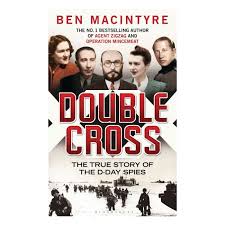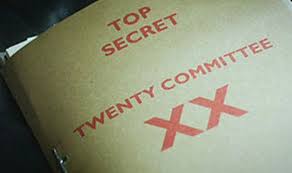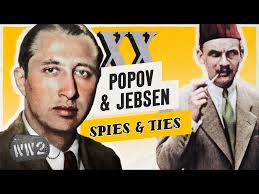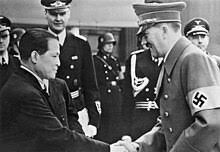Double Cross 1944 (2012) by Ben McIntyre.
GoodReads meta-data is 399 pages, rated 3.97 by 12,264 litizens.
Genre: History.
Tagline: Believe it or not!
Verdict: Quite a story.

Operation Fortitude incorporates the many elements that went into the effort to deceive Germans about the site for the opening of a second front in Western Europe. The six double agents described in this book were the lynchpin of the Operation, but other parts were crucial to create a mutually supportive house of cards.
As one of the British instigators of the Operation said, we only have to convince one German, Hitler, and he will order all others to obey.
It should be borne in mind that the deception continued well past D-Day to cause Hitler to hold German army reserves in place – for more than month into July.
The deception stood on two legs. First, was an inflation of Allied troops in Britain to take part in an invasion and second was the locale of the invasion. These two interacted as will be explained below. Stay tuned.
The aim of the inflation of the forces available (men, armour, and air) was to lead the Germans to the conclusion that there would be a major diversionary attack, followed by the real thing. To make that credible it had to appear that the Allies had 80 or more army divisions in Britain. (A full strength division would field between 10,000 and 15,000 or more troops, capable of sustained tactical warfare. The Allied divisions would be full-strength, while by 1944 many of the German ones were at half-strength.) With forces of this magnitude a diversionary attack could be 20-30 divisions, leaving a 50 or more for the real thing. The diversion, which by definition would be first, could involve as many as 250,000+ soldiers. I’ll come back to the magic that did this inflation below.
Second, as to locale, the important thing was to sow confusion and cause the Germans to split their forces. Several prospects were mooted from Norway (to link with the Soviets in the north) and then bring Sweden into the war, to the Bordeaux region of France (with part of the forces to attack this latter area sailing directly from the United States, as had done the army that landed in North Africa in November 1942), and the Marseilles area using North Africa as a base, as well as the obvious choice: the Pas de Calais. The goal was not to convince them it was one of the other, but to foster uncertainty about which.
The inflation of Allied forces centred on the fictitious FUSAG – First United States Army Group in South eastern England commanded by General George Patton who was much in evidence as though inspecting troops, supervising preparations, briefing officers, enthusing men, and so on. He was the star of a one-man show.
Around him was an army of illusion of a mere 40,000. Equipment, tents, tanks, trucks, aircraft, ships – moved around him for German aerial reconnaissance photographs. Many were props supplied by London stage magicians, movie studio carpenters, and their ilk to create an illusion. Many of vehicles were painted balloons, the barracks were roofs only, the tents were dyed sheets, the ships moored here and there and occasionally moved were plywood facsimiles. All this activity by Patton’s 40,000 was to simulate 500,000 men or more.
Meanwhile, the South East corner of England buzzed with US Army radio traffic. All fictional but most of it contrived on the assumption that the Germans would hear it.
Most of the effort went into focussing in everything but word on the Pas de Calais zone, but a secondary effort of the same kind was aimed at Norway.
The double agents reaffirmed much of this with reports on unit badges of fictitious formations and sightings of important generals, and Churchill himself once. Eisenhower had a second fictitious HQ in the area in which he never set foot, yet streams of radio messages went in and out of it, as did dispatch riders on motorbikes who roared through the local villages sporting phoney unit badges on their shoulders.

As to locale, the greater the spread of possibilities the better. To confirm an attack on Norway, the exiled King of Norway was much seen along Scotland’s east coast, where the many ships of the Norwegian merchant marine assembled. To salt the idea of Marseilles an actor imitating General B Montgomery visited Gibraltar where it was carefully arranged that he should be seen by a well known German spy, a Spanish police officer.
Likewise, reconnaissance flights and bombing missions concentrated on the Pas de Calais and Norway, but Bordeaux and Marseilles were also hit. The latter were each bombarded by the Royal Navy at times.
Meanwhile, the French resistance became very active in the Pas de Calais area, and the Norwegian resistance left a trail of activities that could only be mapping, charting, and sounding inlets and bays for amphibious landings.
Another thread to this tapestry of lies was that an armada was being prepared in the USA and Canada for direct transportation to Bordeaux. German agents in the USA, most double agents for the US, reported all manner of preparation in harbours from Norfolk to Boston and Halifax. That was compounded by indiscrete planted news items concerning troops and generals. The closing of harbours, the heavy security around fenced off military bases (which were mostly empty), the stockpiling of foodstuffs and equipment. This latter would evidently make its way to Normandy, but at the time the hint was that it was Bordeaux bound.

In order to freeze the German strategic reserve in place, the deception continued after D-Day. To preserve their credibility, the double agents made carefully timed reports that implied that there would be a landing at Normandy but that it would be diversionary. In this case, as in all others the reports did not flatly say that but rather scattered clues in the text, allowing the German analysts to connect the dots, which they did.
Did all of this intelligence, creativity, effort, and risk work? Yes.
The 15th Panzers stayed in reserve at Calais for a month after 6 June, waiting for the real invasion to strike there. By the time it was deployed the Allied foothold was secure, Allied force was dominate, tactical airpower was overwhelming and immediate from airfields in France. The Germans could not travel roads in daytime such was the blanket of tactical airpower, so they drove at night. But where?
French Resistance twisted around road signs between Pas de Calais and Normandy. The Germans had erected their own road signs, and these were moved around rather than destroyed, so they looked right but were wrong. More than one unit of artillery, tanks, or infantry followed the signs into a marsh or bluff.
All the while a highly trained mountain army of 250,000 Germans remained in Norway, waiting for the real invasion. Likewise, half of the German troops in France remained concentrated in the south in anticipation of a Mediterranean landing.
That one person who had to believe the lie was Hitler, who had been telling the generals for months that the attack would be at Pas de Calais since (1) it was closest to England and for that reason had been used by Henry V and William the Conqueror for their invasions and (2) it had a deep water harbour with good rail connections and was close to the best harbour in northern Europe at Antwerp. Since Hitler, like all weaklings, could never admit to being wrong, he stuck firmly to that thesis for more than month – nursed along by the misinformation which continued after D-Day, and he held that powerful panzer force for the real invasion to come at Pas de Calais, despite the pleas of the generals facing the invasion.
As the deception unfolded in May and June, MI5 had confirmation that it was working. That came partly from intercepted German radio traffic (which Bletchley Park had cracked long ago, RAF reconnaissance photographs, reports by resistance groups in Norway, Belgium, and France. But the most authoritative source was Hitler himself! Huh?
It seems that he had a particular liking for Baron Oshima, the Japanese ambassador to Nazi Germany, himself a Germanophile who spoke the language fluently and who was an ardent fascist. Though quite how Hitler squared that with his birthright racism and his aversion of close contact with anyone who was not a servile subordinate remains a mystery. Oshima must have been one smooth operator.
Oshima was also a good listener, as many diplomats are, and he often had private tête-à-têtes with Hitler who spoke freely and in some detail to this trusted associate. And I mean private, just the two of them.

As well as a good listener, Oshima also had a prodigious memory and was a conscientious official who, after every meeting with Hitler, would transcribe the conversation and radio it to Tokyo. These reports sometimes ran to 20 or more pages. The US Navy had broken the Japanese diplomatic codes in 1941, and read Oshima’s reports each time. In them, even after 6 June, Hitler was positive that a real attack would come later at Pas de Calais, and told that to Oshima more than once in June and July and the baron passed it on to Tokyo.
Part of the reason for the success of Operation Fortitude was the corruption, incompetence, and internecine conflict among Nazi intelligence agencies. Ideological purity trumped competence. They were ready to undermine and denounce each other, either for personal gain or to out-Nazi each other in finding traitors under every bed, and so to save their own necks spymasters had to paper over every crack, double down on every assertion, and overstate the cases they were making to deflect this rivalry. The effect was to cause German intelligence officers to emphasise the positive, and hide the negative from their murderous rivals. Yes, I know it sounds like McKinsey management.
While the Fortitude orchestra of deception played more or less from the same music, there were wild cards. There was one freelance interloper, who had offered his services to the Germans as a spy, claiming to have a network of twenty or more informants in Great Britain. These twenty were complete fantasy but the German foreign intelligence services combined being inept with a thirst for knowledge and they bought this lie. This individual lived in the City of Spies that Lisbon became.
The Iberian fantasist just might, in spewing out nonsense, include Normandy. The Brits had tumbled on to him early on and let him run to sew confusion with the Germans, but now the stakes were both high and immediate. Should they continue to ignore him, or silence him (by kidnap or murder). In the end the decision was to let him continue so as to drown the Germans in information. Though the Germans listened to this Iberian, they were somewhat skeptical because his reports were always much more explicit than the double agents the British were running. In short, his reports often seemed too good to be true, and also they did not have the confirmation of other activities as enumerated above, like aerial reconnaissance, fabricated radio traffic, body doubles, and the like.
While the double agents risked their lives, most of their work was done in Lisbon or London sending back misinformation to their respective spymasters of things they and their fantasy networks of agents in Great Britain had seen or overheard. However, one was kidnapped from Lisbon by the Gestapo and returned to Germany where he did not survive interrogation, but miraculously did not give away the plan. His arrest had to do with embezzlement not spying. He was crooked all the way around.
While the double agents did their jobs, being chancers, odd balls, and worse, their British spymasters found them personally distasteful. The agents were certainly not ‘one of us’ from Cambridge. This disdain often showed in their treatment of these assets. One of the irritating qualities nearly all of them had, was the refusal to be bought. Money was not a means of control for any of them. They hated the Nazis, that was motivation enough. Most were pro-British even Anglophile, but there was one, who hated the Nazis, but did not love the British, and this annoyed her case officers constantly. She said sarcastically once, that she would not sing ‘Rule Britannia’ while listening to German officers’ loose lips in occupied Paris. This witticism drove her case officer into a paroxysm of temper, while she laughed in his face. When endangered she was abstracted from Paris and sequestered in a safe house in London for months to keep her cover intact. When her usefulness was at an end she was more or less literally turned out into the street and and charged back rent on the safe house to which she had been confined for months at a time. Such was the thanks of a grateful nation.
By the way ‘Double Cross’ did not refer directly to the deception, rather it was the roman numeral XX, and the committee that had hatched Operation Fortitude was Committee 20, there being 19 others. Of course, the designation Double Cross took on a second meaning as the event proceeded.
Side note. While not wholly relevant to this story, I am reminded of the fact that Hitler liked bigger and better weapons, and one of those was the 70-ton King Tiger tank. By contrast the Panther tanks that led the invasions of Poland and France weighed in at just under 9-tons. The King Tiger was indeed formidable and perhaps a hundred of these steel monsters reposed around Calais. But once deployed they were their own worst enemy: They consumed twice as much fuel as any other German tank, had a commensurate short range between refuellings, were too wide for country roads and lanes in Normandy’s bocage, were too heavy for nearly all bridges in Northern France, and their ammunition was incompatible with other tanks. They also presented Allied tactical bombers with big, slow moving targets if they moved in daylight. But they had shock absorbers and some kind of air conditioning for the crew who sat on leather covered seats. The result was that few of these behemoths contributed to the battles that followed. They had been designed and built for the open plains of Hungary, Poland, Ukraine, Belorussia but Hitler had withdrawn from there to sit in France. Later they were not able to pass through the forest paths and roads in the Ardennes and did not have enough fuel during the Battle of the Bulge and many of them sat idly behind the lines. Such was the genius of Hitler.
———

